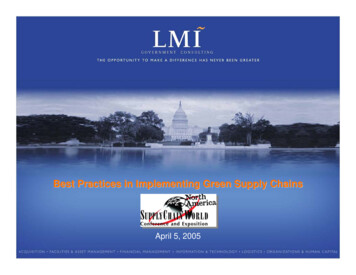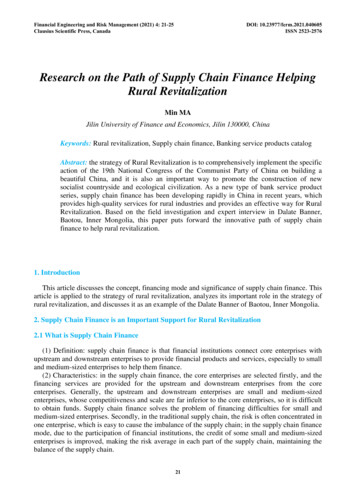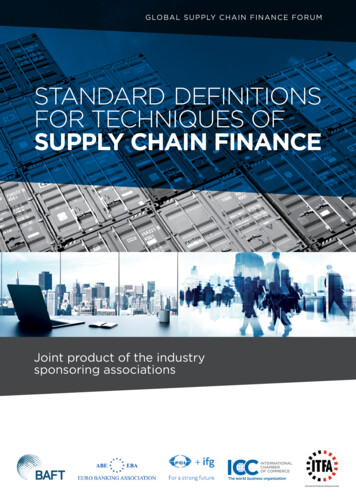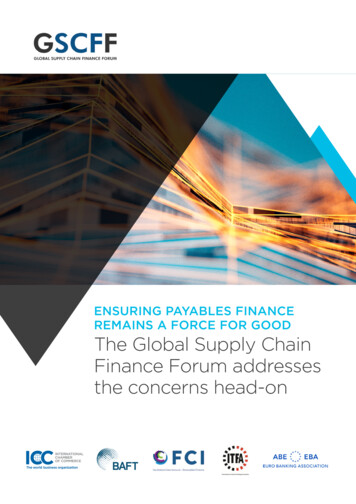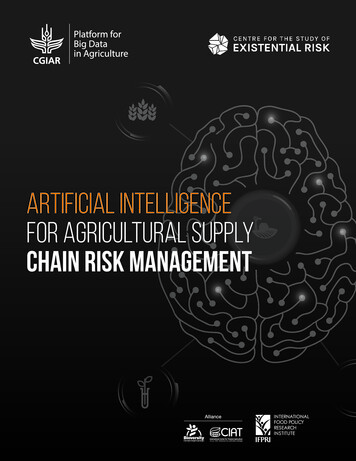
Transcription
Trends inSupply Chain FinanceSupplierPay Meeting 17 November 2014David GustinManaging Director, Global Business IntelligenceCo-founder, Trade Financing MattersCopyright 2014 Global Business Intelligence . All rights reserved. Not for distribution.1
Discussions Topics Clarify Confusion around Supply Chain Finance Nomenclature Overview of Early Pay Techniques Critical Issues– P2P Complexity: Direct vs Indirect Supplier Expenses– SupplierPay - Do Corporates want to be a Bank to theirSuppliers?– Where are the Banks?– New Models disaggregating Banks and Factors forbusiness credit Key Questions to AddressCopyright 2014 Global Business Intelligence . All rights reserved. Not for distribution.2
The vast majority of trade credit sits on companiesbalance sheets in the form of payables and receivables. Trade finance is a large, global andinterconnected industry, encompassingnearly 8tn in notional credit*. Most of trade credit ( 7.5tn) is notintermediated directly and remains oncorporate balance sheets (in the form oftrade receivables). Banks are the main third party source offinancing for corporate trade, butintermediate roughly 500bn of tradecredit (12%).*Note: 2tn in USA, an estimated 3 trillionEuros of accounts receivables outstanding inthe EU, estimated 8tn globallyCopyright 2014 Global Business Intelligence . All rights reserved. Not for distribution.3
Nomenclature and Definitions Matter The term Supply Chain Finance is not universallyaccepted nor well defined. Self-Funded Early Pay– Supplier gets paid earlier than the due date onthe invoice and money comes from the balancesheet of the buyer (egs. static discounting,dynamic discounting) Funded by Third Party(Factor, Bank, Non Bank, Pcard)– What the market calls Supply Chain Finance –ie Taulia’s TED program or PrimeRevenue’smulti-bank model, or Orbian’s capital marketsmodel — is when the supplier is paid early butthe money comes from someone other than thebuyer. In addition, important to point out there are five maintriggers that we see for supply chain finance that caninvolve taking information to trigger liquidity.Copyright 2014 Global Business Intelligence . All rights reserved. Not for distribution.4
Early Pay TechniquesBuyer FocusedSeller FocusedTechniqueDescriptionSupply ChainFinanceSupply chain finance is an uncommitted credit facilitytypically with near investment grade corporationsthat rely on approved invoices to fund receivables.DynamicDiscountingDiscounts are offered on all invoices approved,opening up the entire procurement spend, based ona sliding scale.Reverse AuctionsBuyer sets APR rates and submits approvedinvoices for suppliers to bid.PcardsSmall suppliers and low dollar invoices typicallyfunded by a bank (eg. U.S. Bank, Citibank)Seller AuctionsAn alternative to factoring where companies sellsingle invoices that are not credit enhanced on anexchange.FactoringFactoring consists of several distinct services:receivables monitoring and collection, creditassessment, payment guarantees and financing. It isseller-focused as opposed to SCF and dynamicdiscounting that are buyer focused.Copyright 2014 Global Business Intelligence . All rights reserved. Not for distribution.5
How Supply Chain Finance differs from Dynamic Discounting Dynamic Discounting requires nobank line. Programs can be doneby any corporate, investmentgrade, non rated, non investmentgrade, etc. Supply Chain Finance is a creditand cash management product,and focuses only on investmentgrade or near investment gradecompanies SCF programs typically have aROI and that is tied to DPOextension. Funders typically “buy”receivables which makes itdifficult to profitably implementbank funded SCF programs forSME buyers. (KYC, UCC filingcosts, etc.) Supply ChainFinance SCF program rates are based onLibor or Euribor plus a spreadCopyright 2014 Global Business Intelligence . All rights reserved. Not for distribution. Corporates tend to self-fundusing their own surplus cash(although options are beingdeveloped to use third party nonDynamic bank funds).Discounting Funding is based on based offTreasury hurdle rates and haveAPRs approaching 20% Typically focused on the long tailof suppliers (smaller, moreindirect spend)6
Early Pay Finance Options Tend to Get PositionedBased on Relative Size of Suppliers“Approved”Payable Financeaimed hereHow big of a challenge is pledged receivables?Annual SpendHighCan solutions m.ove in this direction byoffering more competitive rates?Can P-card providers changeInterchange structure to goupstream?P-Cards, Discounting, and Factoringsolutions for smaller vendors,typically indirect spend purchasesLow 50100200Copyright 2014 Global Business Intelligence . All rights reserved. Not for distribution.# Suppliers1,000’s7
Relative Size – Select Early Pay ModelsSize of Market– Various Approved Invoice based funding methodsTotal Invoice Value bn 400 350 300 250 350 245 200 150 100 50 -Approved Payable Pcard (N.A. only)Finance 10 8DynamicDiscountingOnline InvoiceAuctionsSource: GBI Analysis, RPMG 2012 Pcard studyCopyright 2014 Global Business Intelligence . All rights reserved. Not for distribution.8
Purchase-to-Pay ComplexityPercentage/share of spend in different categories– Direct– MRO/Catalog– Specialized - Print, Telecom, Marketing, Logistics, IT, etc.)– Services(simple complex)– Contingent Labor– T&E– Other indirect/catalogCopyright 2014 Global Business Intelligence . All rights reserved. Not for distribution.9
Do we want our Large Corporations to be Banks to theirSuppliers? Material effect on balance sheet What is the role of third parties to finance these early payprograms? Three drivers for Non Bank funding– Technology enabling (B2B, einvoicing, data warehouses,analytics, etc.)– Zero interest rate environment impact on Corporate Treasurers Investors– Vast regulation unintended consequences arbitrageopportunitiesCopyright 2014 Global Business Intelligence . All rights reserved. Not for distribution.10
Bank regulatory costs become less efficient than third partyat less than investment grade, creating AAAAASample: Corporate BondsSource: Conning; Institution of International FinanceACopyright 2014 Global Business Intelligence . All rights reserved. Not for distribution.BBBBBB11
Diagram of Business Bank and DisintermediationBusiness Banking“Disrupters” Checking Account Cash Management Lending / Credit- Commercial Purchasing cards- Line of Credit (Letter of Credit)- Loans Small Business Installment Commercial Mortgage- Working Capital Loans Asset Based Lending Factoring Invoice Discounting Line Distributor finance Supply Chain FinanceCopyright 2014 Global Business Intelligence . All rights reserved. Not for distribution.12
Factoring versus P2P Supplier Network ModelFactoring Model Relationship and Operationintensive Seller-focused Labor intensive Factoring consists of severaldistinct services: receivablesmonitoring and collection, creditassessment, paymentguarantees and financing. Focused on small to mid market Risk is highly concentrated in onesector – RETAIL (footwear,apparel, furniture,etc.) Essentially you have majorBig Buy retail that are theobligors to these factoringcompanies.Copyright 2014 Global Business Intelligence . All rights reserved. Not for distribution.P2P Model Approved invoice (Buyer focused) Typically large global names asObligor Supplier onboarding facilitated byBuyer Provides great efficiency play forBuyer (business rules, workflow,dispute resolution, etc.) and supplier(customer service, etc.) APRs 20% Cash acceleration 20 days13
Key Questions to Address Spend Analytics – how long is your tail and have you put existingprograms in place for early pay? Do you have the technology to manage Early Pay? E-invoicing,eProcurement, ERP, etc. Most companies have ERP systems, but thegoal is to get all invoices submitted electronically from suppliers in ano-touch/low-touch manner so that cash can be truly optimized. Onboarding suppliers is always a challenge, regardless of technique– can you commit resources? Governance issues – Finance vs. procurement misalignment andconflicting KPIs- increase DPO versus Healthy Supply chain- How willyou navigate? Do you have the ability to enforce and monitor the success ofprograms?Copyright 2014 Global Business Intelligence . All rights reserved. Not for distribution.14
Any Questions?David GustinPresident, Global Business IntelligenceCo-Founder and Managing Director, Trade Financing rs.com/tfmattersphone: 001- 604-924-0851Copyright 2014 Global Business Intelligence . All rights reserved. Not for distribution.15
How Supply Chain Finance differs from Dynamic Discounting Supply Chain Finance is a credit and cash management product, and focuses only on investment grade or near investment grade companies SCF programs typically have a ROI and that is tied to DPO extension. Funders typically "buy" Dynamic Discounting requires no bank line.




